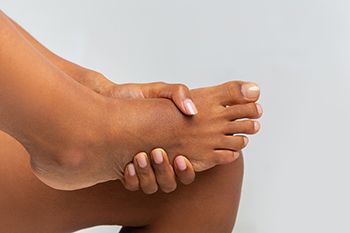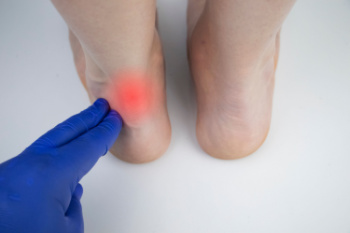Items filtered by date: May 2024
Managing Sprained Ankles From Volleyball

Ankle sprains are the most common injury sustained by volleyball players. They often result in significant lost playing time and affect overall performance. Ankle sprains typically occur when a player overstretches or tears the ankle joint ligaments while diving for the ball or landing the wrong way after a jump. A sprain can also result from landing on another player's foot. Treating and preventing ankle sprains is essential to avoid long-term problems, such as chronic pain, arthritis, and ongoing instability. Immediate treatment focuses on reducing pain, swelling, and stabilizing the ankle joint. Depending on the severity of the sprain, recovery times and treatment plans will vary. To further prevent future sprains, an ankle brace may be recommended during play along with maintaining a routine of rehabilitation exercises aimed at rebuilding strength and balance. If you experience severe pain, swelling, or instability in your ankle, it is suggested that you schedule an appointment with a podiatrist for an exam and treatment plan.
Ankle sprains are common but need immediate attention. If you need your feet checked, contact Brian Doerr, DPM from Florida. Our doctor can provide the care you need to keep you pain-free and on your feet.
How Does an Ankle Sprain Occur?
Ankle sprains take place when the ligaments in your ankle are torn or stretched beyond their limits. There are multiple ways that the ankle can become injured, including twisting or rolling over onto your ankle, putting undue stress on it, or causing trauma to the ankle itself.
What Are the Symptoms?
- Mild to moderate bruising
- Limited mobility
- Swelling
- Discoloration of the skin (depending on severity)
Preventing a Sprain
- Wearing appropriate shoes for the occasion
- Stretching before exercises and sports
- Knowing your limits
Treatment of a Sprain
Treatment of a sprain depends on the severity. Many times, people are told to rest and remain off their feet completely, while others are given an air cast. If the sprain is very severe, surgery may be required.
If you have suffered an ankle sprain previously, you may want to consider additional support such as a brace and regular exercises to strengthen the ankle.
If you have any questions please feel free to contact our office located in Fort Meyers, FL . We offer the newest diagnostic and treatment technologies for all your foot and ankle needs.
Foot and Ankle Injuries Common Among Dancers

Foot and ankle injuries are common among dancers, posing significant challenges to their performance and well-being. Achilles tendonitis is the result of repetitive strain on the Achilles tendon and can lead to inflammation and tightness, affecting movement and stability. Ankle sprains, resulting from overstretching or tearing of ligaments, are among the most common dance injuries, causing pain, swelling, and reduced mobility. Stress fractures are hairline cracks in bones of the feet brought about by repetitive impact or overuse. By incorporating proper warm-up and cool-down routines, maintaining correct technique, and integrating strength and flexibility exercises into training, a dancer can help reduce the likelihood of injury. Additionally, wearing supportive footwear and listening to the body's signals can further safeguard against potential harm. When faced with such dance injuries, seeking assistance from a podiatrist is essential. These foot doctors can diagnose the root cause of the injury and recommend the appropriate treatment plan to aid in recovery. If you are a dancer, it is suggested that you include a podiatrist as part of your medical team.
Ankle and foot injuries are common among athletes and in many sports. They can be caused by several problems and may be potentially serious. If you are feeling pain or think you were injured in a sporting event or when exercising, consult with Brian Doerr, DPM from Florida. Our doctor will assess your condition and provide you with quality foot and ankle treatment.
Common Injuries
The most common injuries that occur in sporting activities include:
- Achilles Tendonitis
- Achilles Tendon Rupture
- Ankle Sprains
- Broken Foot
- Plantar Fasciitis
- Stress Fractures
- Turf Toe
Symptoms
Symptoms vary depending upon the injury and in some cases, there may be no symptoms at all. However, in most cases, some form of symptom is experienced. Pain, aching, burning, bruising, tenderness, tightness or stiffness, sensation loss, difficulty moving, and swelling are the most common symptoms.
Treatment
Just as symptoms vary depending upon the injury, so do treatment options. A common treatment method is known as the RICE method. This method involves rest, applying ice, compression and elevating the afflicted foot or ankle. If the injury appears to be more serious, surgery might be required, such as arthroscopic or reconstructive surgery. Lastly, rehabilitation or therapy might be needed to gain full functionality in the afflicted area. Any discomfort experienced by an athlete must be evaluated by a licensed, reputable medical professional.
If you have any questions, please feel free to contact our office located in Fort Meyers, FL . We offer the newest diagnostic and treatment technologies for all your foot care needs.
Plantar Warts Can Be Treated!
What Is a Plantar Fibroma?

Plantar fibroma, a condition affecting the foot's plantar fascia, is a non-cancerous growth or nodule within the arch. This fibrous tissue thickening can cause discomfort and pain, particularly while walking or standing for prolonged periods. Unlike a cyst or wart, a plantar fibroma feels firm to the touch and typically does not move under the skin. The exact cause of this condition remains unclear, although factors such as trauma or genetics may play a role in its development. Symptoms include a noticeable lump or mass in the arch of the foot, accompanied by tenderness or pain, especially when pressure is applied. Over time, the fibroma may increase in size, potentially affecting mobility and overall foot function. Diagnosis usually involves a physical examination by a podiatrist with treatment options ranging from orthotics and stretching exercises to surgical intervention, in more severe cases. If you have an uncomfortable lump on the sole or arch of your foot, it is suggested that you consult a podiatrist who can diagnose and treat a plantar fibroma.
A plantar fibroma may disrupt your daily activities. If you have any concerns, contact Brian Doerr, DPM of Florida. Our doctor can provide the care you need to keep you pain-free and on your feet.
Plantar Fibroma
A plantar fibroma is a fibrous knot in the arch of the foot. It is embedded in the plantar fascia which is a band of tissue that extends from the heel to the toes along the bottom of the foot. There can be multiple plantar fibromas in the feet at the same time. There are no known causes for this condition. If you have a plantar fibroma, there will be a bump in the arch of your foot that cannot be missed. Any associated pain is most often due to a shoe rubbing against the nodule. Non-surgical options, such as steroid injections, physical therapy, and orthotics should be tried first. Surgery is a last resort and is the only thing that will remove a plantar fibroma entirely. Consult with a podiatrist for a proper diagnosis and to determine the treatment regimen that is right for you.
What Causes a Plantar Fibroma?
While there are no specific causes identified, a plantar fibroma can possibly come from genetic predisposition or the formation of scar tissue that forms from healing the tears in the plantar fascia.
What Are the Symptoms of a Plantar Fibroma?
There will be a noticeable lump in the arch of the foot that may or may not cause pain. If pain is felt, it is typically because a shoe is rubbing up against the lump or when walking or standing barefoot.
Treatment and Prevention
A plantar fibroma will not disappear without treatment, but it can get smaller and be a non-issue. If pain persists, a podiatrist examines the foot and when the arch of the foot is pressed, pain can be felt down to the toes. An MRI or biopsy might be performed to help diagnose or evaluate the plantar fibroma. The following non-surgical options are generally enough to reduce the size and pain of these nodules:
- Steroid injections
- Orthotics
- Physical therapy to help apply anti-inflammatory creams on the bump
Surgery is considered if the mass increases in size and the patient continues to feel pain after non-surgical methods are tried.
If you have any questions please feel free to contact our office located in Fort Meyers, FL . We offer the newest diagnostic tools and technology to treat your foot and ankle needs.
Common Symptoms of an Achilles Tendon Injury

The Achilles tendon, the largest tendon in the body, plays an essential role in facilitating movement and stability in the lower extremities. When injured, this vital structure can cause significant discomfort and impairment. One common symptom of an Achilles tendon injury is pain and stiffness along the back of the heel or calf, particularly during physical activity or when stretching the foot. Swelling and tenderness may also be present in the affected area, accompanied by a sensation of warmth or redness. In some cases, individuals may experience a noticeable decrease in strength or flexibility in the ankle joint. Achilles tendon injuries can range from mild strains to more severe conditions, such as tendonitis or ruptures, which may require medical intervention for proper management and healing. Recognizing these symptoms is vital for a prompt diagnosis and treatment. If you have endured this type of injury, it is strongly suggested that you confer with a podiatrist who can begin the appropriate treatment method.
Achilles tendon injuries need immediate attention to avoid future complications. If you have any concerns, contact Brian Doerr, DPM of Florida. Our doctor can provide the care you need to keep you pain-free and on your feet.
What Is the Achilles Tendon?
The Achilles tendon is a tendon that connects the lower leg muscles and calf to the heel of the foot. It is the strongest tendon in the human body and is essential for making movement possible. Because this tendon is such an integral part of the body, any injuries to it can create immense difficulties and should immediately be presented to a doctor.
What Are the Symptoms of an Achilles Tendon Injury?
There are various types of injuries that can affect the Achilles tendon. The two most common injuries are Achilles tendinitis and ruptures of the tendon.
Achilles Tendinitis Symptoms
- Inflammation
- Dull to severe pain
- Increased blood flow to the tendon
- Thickening of the tendon
Rupture Symptoms
- Extreme pain and swelling in the foot
- Total immobility
Treatment and Prevention
Achilles tendon injuries are diagnosed by a thorough physical evaluation, which can include an MRI. Treatment involves rest, physical therapy, and in some cases, surgery. However, various preventative measures can be taken to avoid these injuries, such as:
- Thorough stretching of the tendon before and after exercise
- Strengthening exercises like calf raises, squats, leg curls, leg extensions, leg raises, lunges, and leg presses
If you have any questions please feel free to contact our office located in Fort Meyers, FL . We offer the newest diagnostic tools and technology to treat your foot and ankle needs.

